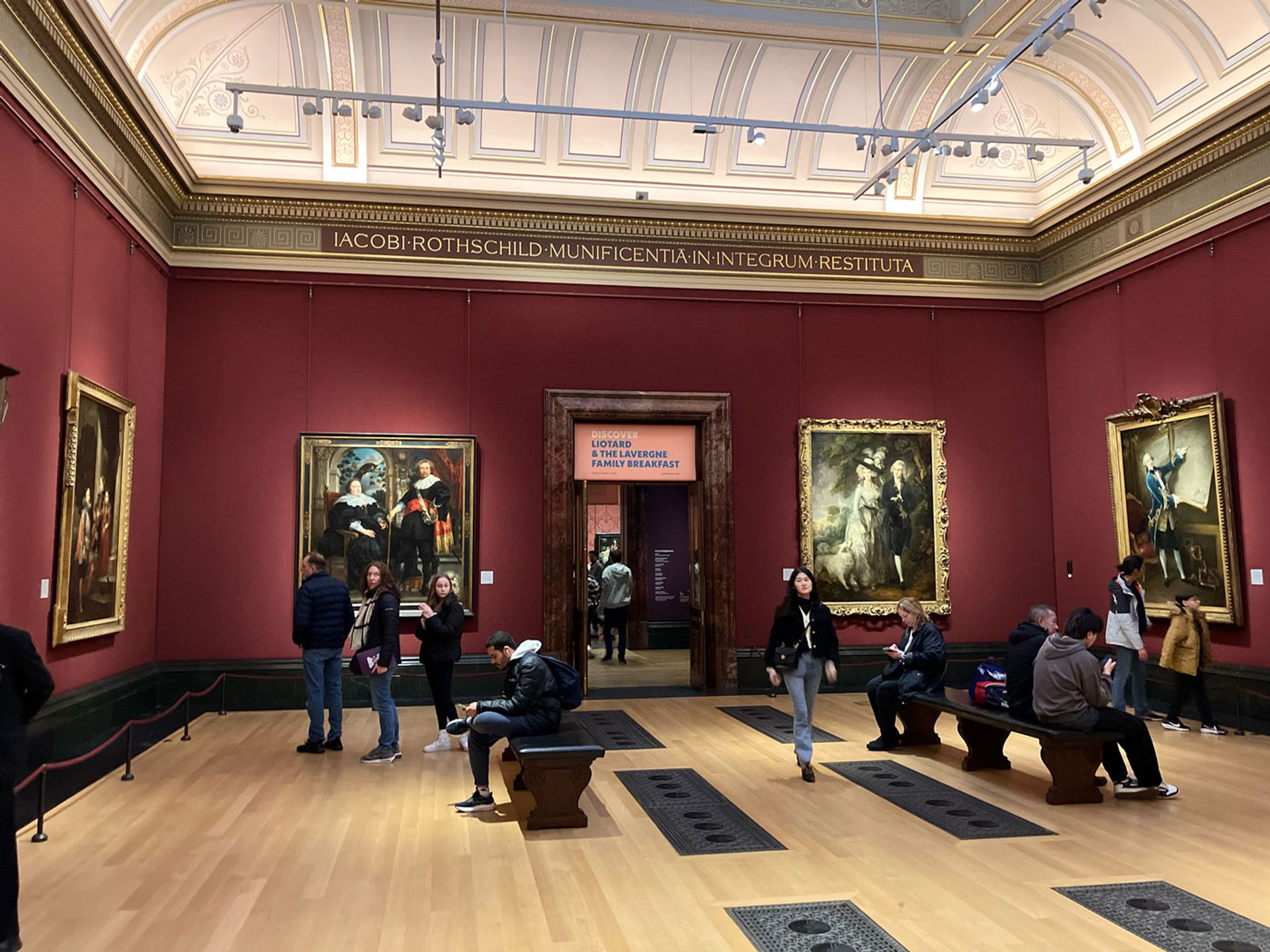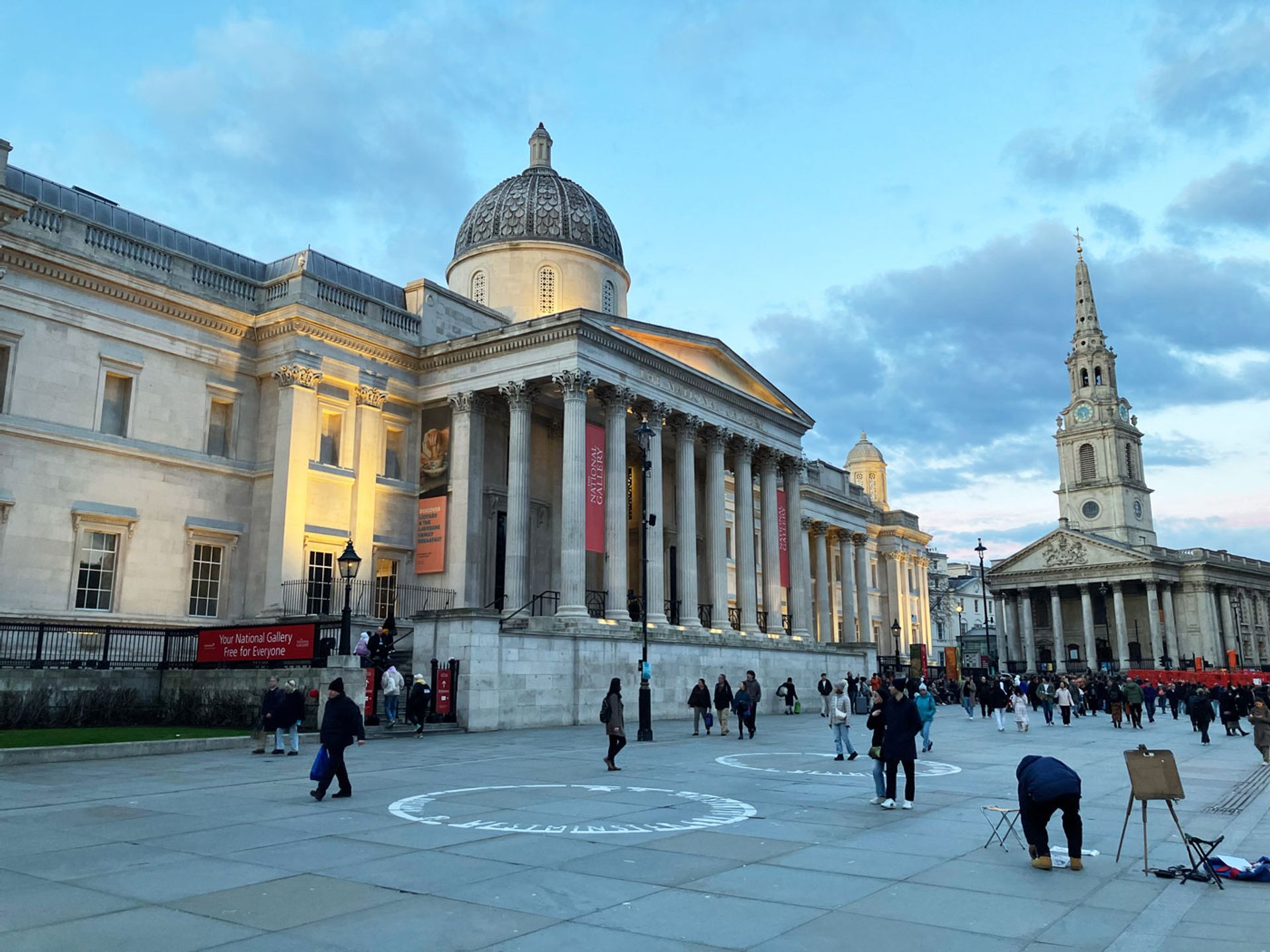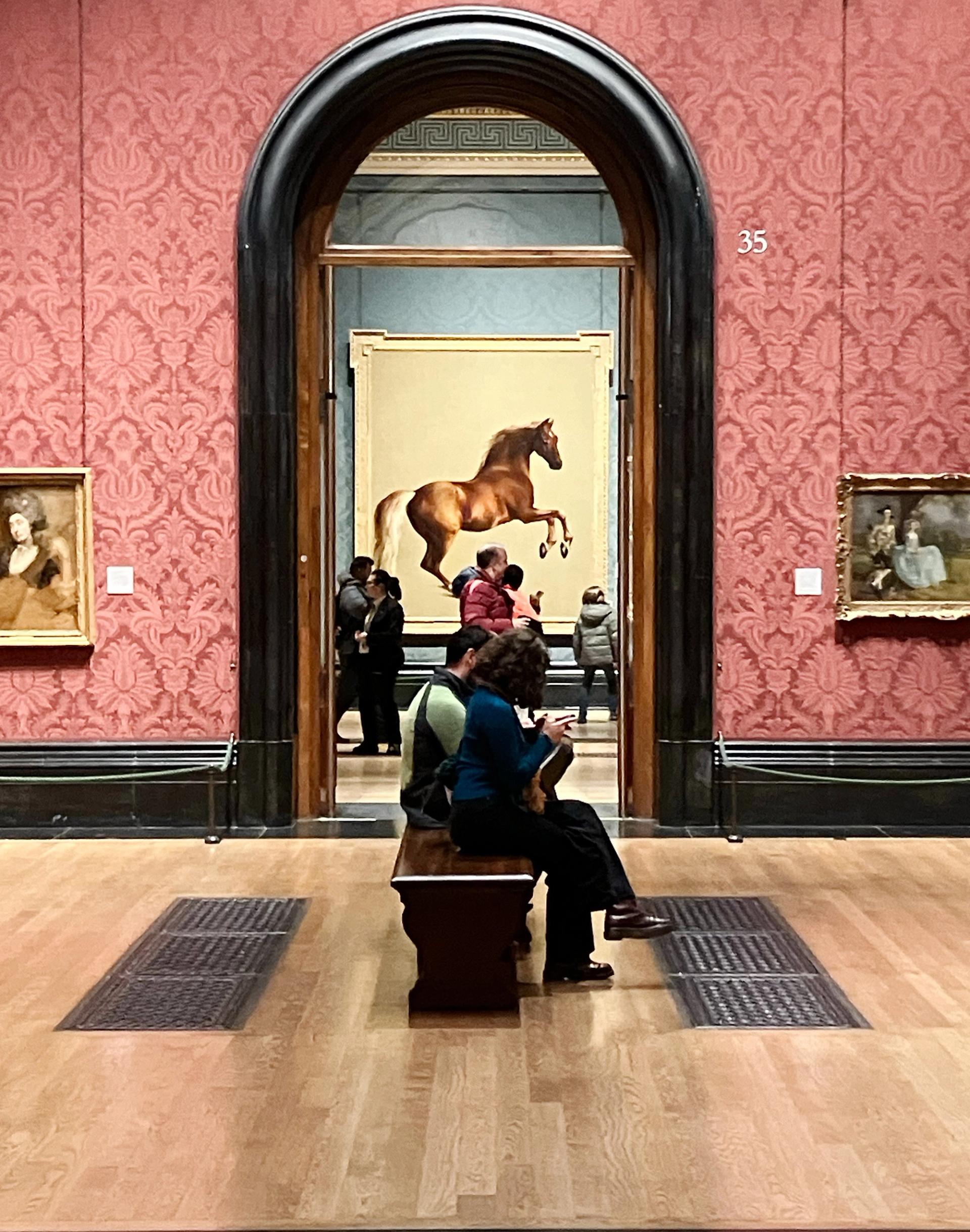The National Gallery in London is well into a £85m project to upgrade its Sainsbury Wing entrance and provide new facilities to celebrate its 200th anniversary. It had been hoped the wing would reopen this month, but work has taken longer than expected and the reopening is now scheduled for May 2025.
In an in-depth interview with The Art Newspaper, Gabriele Finaldi, the gallery’s director, speaks about his plans for a complete rehang of the collection—a “once-in-a-generation” opportunity. Although the redisplay will follow the previous chronological trajectory, there will be some noticeable changes and new juxtapositions. For instance, the gallery’s 17 Monets will go into a single room, providing a “mini-monographic” display.
Finaldi also speaks frankly about the impact of climate protesters who targeted John Constable’s Hay Wain in July 2022, Vincent van Gogh’s Sunflowers in October 2022 and Diego Velázquez’s “Rokeby Venus”, in November 2023. The Velázquez incident, involving a hammer, represents “a gear shift to a more brutal and violent attack”, Finaldi says.

Diego Velazquez’s “Rokeby Venus”. The hammer attack on the painting, one of the National Gallery’s most prized works, by protesters in November 2023, was, Finaldi says, “a gear shift to a more brutal and violent attack” Courtesy National Gallery
Reluctantly, the gallery has recently glazed several hundred of its most important paintings which had not previously been glass-protected. Finaldi explains: “It is costly and puts them at one slight remove from the public, since it pushes the painting a little further back into the frame and produces a deeper shadow at the top of the picture.”
In the 1990s the National Gallery proclaimed “from the Tube to the Titians in three minutes”. Entering the gallery is now slower, because of security checks, but this normally short delay is “part of modern life”. The process will hopefully be streamlined when the Sainsbury Wing reopens next year.
The cornerstone contributions have come from the Sainsbury family, along with donations from the Garfield Weston Foundation and our own chairman, John Booth
Gabriele Finaldi
When the Sainsbury Wing remodelling was being planned, it was assumed that visitor numbers would eventually rise from six million a year to seven million. But the gallery has lagged behind the other major London museums in recovering from the impact of Covid-19. Last year the total was 3.1 million, although Finaldi anticipates four million in 2024, thanks partly to the 200th anniversary publicity.
Although it is often assumed that most of the National Gallery’s collection is on view, this is far from the case. There are at present 600 paintings on show, out of a total of 2,400. When the Sainsbury Wing reopens, the number will rise to 1,000, although Finaldi admits this is not enough. Ideally he would like to hang up to 1,400 pictures.
That higher number will depend on a future development project: the demolition of the adjacent St Vincent House (which is owned by the gallery and leased out) and its replacement by a new building almost as large as the Sainsbury Wing. This would provide more permanent collection space and much improved galleries for temporary shows. It will cost many hundreds of millions of pounds and will not be completed until well into the 2030s.
‘The bicentenary will be a good investment opportunity’
The Art Newspaper: The National Gallery is to mark the 200th anniversary of its establishment in 1824. But after the birthday celebrations, what will be the long-term impact of the year?
Gabriele Finaldi: This is something we have thought about a lot. The bicentenary will be a good investment opportunity—investment in the broadest sense. What do we think of as legacy? Most significant of all will be a renewed Sainsbury Wing, creating a building that’s welcoming, luminous, efficient, beautiful, spacious. The recent welcome for visitors at the gallery has been a little bit mediocre.
We will also be creating a new research centre, which should become the prime institution for the study of Old Master paintings in the UK. There will be a “supporters’ house” to provide facilities for members and donors. The new creative learning centre will be the biggest in any UK art museum. And we want to open up the outdoor space in front of the Sainsbury Wing, a bit like the National Portrait Gallery has just done.
Have you raised the money?
The NG200 project will cost around £95m, of which we have already raised £90m—£10m is going for our programme of activities in 2024-25 and the building work will cost £85m. The cornerstone contributions have come from the Sainsbury family, along with donations from the Garfield Weston Foundation and our own chairman, John Booth.
And what is the timing for the reopening of the Sainsbury Wing? It was originally due to reopen this month.
It will now open in May 2025, the start of our “reopening” year. Building work is going well and we will deliver the enhanced entrance, learning centre and supporters’ house. We will then have a gap in the work of about a year, to enjoy the reopening, and the research centre and the underground link to the original building will be completed in 2027-28.
With the reopening of the Sainsbury Wing, there is an unusual opportunity to redisplay the collection. That must be one of the most enjoyable aspects of your job. What are your plans?
Yes, the redisplay should be one of the most exciting elements of the bicentenary celebrations. It’s a once-in-a-generation opportunity.
The redisplay will broadly retain the same chronological arrangement, beginning with the early Italian paintings in the Sainsbury Wing—and then moving on eastwards in the original Wilkins Building. We are rethinking the story we want to tell. There will be an opportunity to showcase newly restored pictures, such as Uccello’s The Battle of San Romano (around 1438-40) and Orazio Gentileschi’s The Finding of Moses (early 1630s).

Finaldi says that the planned rehang of the National Gallery collection will keep the same chronological ordering but with some incisive interventions: “With Monet, for example, we might bring all 17 paintings together in one room” Photograph: The Art Newspaper
We will also break up the chronology occasionally, to make interesting juxtapositions and incisive interventions. For instance, for the first time we will show Vigée Le Brun’s Self Portrait in a Straw Hat (1782) next to the painting it was inspired by, Rubens’s portrait Le Chapeau de Paille (around 1622-25). They have never previously been shown side by side.
We want to show up the strengths of the collection, such as Titian. With Monet, for example, we might bring all 17 paintings together in one room, to provide a mini-monographical display—until now they have been scattered in two rooms.
But I am keen to retain a certain familiarity, for those who love the gallery and have been visiting for many years. The paintings which can be seen down long axes, such as Raphael’s Mond Crucifixion (1502-03) and Stubbs’s Whistlejacket (around 1762) at the other end will probably remain where they are.
What are your priorities for acquisitions?
To add excellence to excellence. To take a very recent example, acquiring Poussin’s Eucharist (around 1637-40), to hang alongside another of his Seven Sacraments series, Marriage.
We are also always interested in exploring new aspects of the history of European art, such as works done outside Europe in the European tradition.
We were particularly delighted to acquire Artemisia Gentileschi’s Self Portrait as Saint Catherine of Alexandria (around 1615-17), by a very significant 17th-century artist—and a female artist. We are not seeking gender parity, but there is public interest in the history of women painters in Europe and why they are not more evident in historic collections. We have also just announced a new acquisition by the French Impressionist Eva Gonzalès, a striking portrait.
Disappointingly, your visitor numbers have slumped since Covid-19. In the year before the pandemic you had six million—and last year it was down to 3.1 million, nearly half.
It’s not disappointing: 3.1 million is a huge number of people. The Sainsbury Wing was closed last year. Before that we were very heavily visited by foreign visitors, and tourism in the UK was not back to where it was pre-Covid. This year we are expecting around four million, partly because of the bicentenary effect.
But when you were planning the Sainsbury Wing project you were expecting seven million within a few years.
There was then every reason to think there would be an inexorable rise. But that was partly from international tourism, particularly from Asia, and that came to a sudden stop. We also depend on European visitors, and post-Brexit students have found it more difficult to come to the UK, since they require a passport, instead of a national identity card.
You have talked about the importance of welcoming visitors, but of course security is important, particularly after the attacks on Constable’s The Hay Wain (1821) in July 2022, Van Gogh’s Sunflowers (1888) in October 2022 and Velázquez’s “Rokeby Venus” (around 1647-51) in November 2023. I would not expect you to discuss security in any detail, but how do you reconcile security and welcoming?
It’s a big challenge. We want to be accessible and we want the pictures to be enjoyed, but at the same time we need to keep the collection and people safe. Marrying sometimes conflicting ambitions is difficult.
The attacks on National Gallery pictures have been very distressing. They have led us to tighten security, of course. The attack on the “Rokeby Venus” involved an exceptional level of violence. It would be difficult to say that if you take a hammer to the picture your intention was not to damage it. It was a gear shift to a more brutal and violent attack.
What changes have had to be introduced?
More of our pictures are glazed now, including several hundred more added in the past 18 months or so. This is unfortunate. It is costly and puts them at one slight remove from the public, since it pushes the painting a little further back into the frame and produces a deeper shadow at the top of the picture. It is not as easy to enjoy the painterly qualities of the execution of a Rubens, for example.

The present main entrance to the National Gallery: “We need to make the collection as secure as possible,” Finaldi says, “as well as making the visit as pleasurable as possible” Photograph: The Art Newspaper
In the 1990s the National Gallery would say “from the Tube to the Titians in three minutes”. Now entering the gallery is a bit slower, although it is necessary. But the delay is not a long one. It’s part of modern life.
We need to make the collection as secure as possible, as well as making the visit as pleasurable as possible. With the new Sainsbury Wing entrance, we can streamline that process. We want the collection to be enjoyable, but in making it so we have to accept that it becomes a little bit vulnerable.
How many paintings will be on display? With the closure of the Sainsbury Wing, there arearound 600 on show. But with just over 2,300 in the collection, that is a quarter. Is this a concern?
There is still a lot to see—and we can arrange for individuals to see works that are not on display. But we should be aiming for a fuller representation of the collection.
When we reopen we expect to show about 1,000 paintings. We are making every effort to keep all the masterpieces here in 2025-26 for the reopening. We are therefore reducing loan commitments dramatically for this year.
Ideally how many pictures of quality would you like to show?
Percentage-wise on reopening we will probably have more on display than any major art museum in the UK. A thousand is a number that we would like to work up from. Maybe we should ultimately aim for 1,300 to 1,400 pictures.

“I am keen to retain a certain familiarity”. Finaldi says that, in the planned rehang of the National Gallery, the paintings which seen down long axes, such as George Stubbs’s Whistlejacket (around 1762, pictured) will probably remain where they are Photograph: The Art Newspaper
Beyond the opening of the new entrance, there is an even more ambitious project: to demolish the neighbouring St Vincent House and replace it with a new wing for the gallery. Tell us more.
Internally, we are thinking about it a lot. We have undertaken some initial studies, looking at various options. It would provide more room for the permanent collection and new temporary exhibition galleries, to give us the flexibility and space which we need. That would be for the 2030s.
It will surely be very expensive, some hundreds of millions of pounds?
Yes. It would be almost as large as the Sainsbury Wing (37,000 sq. m).
King Charles III is your patron. What does this actually mean?
The King is a great supporter, he loves coming here. He was our trustee in 1986-93. It is good for our public and benefactors to know that the Crown supports us.
The Royal Collection has been exceptionally generous to the gallery over many years with loans. We currently have Mantegna’s Triumphs of Caesar (1484-1506) on loan from Hampton Court. For our bicentenary year we hope to show some Royal Collection pictures which have a connection with ours.

